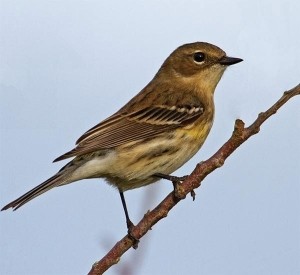It is an aster in winter, sun through the clouds – a force of nature called the yellow-rumped warbler. Find its buttery warmth even when life outside seems to groan or crunch or crack in the cold.
By now the songbird rainbow in our forest has vanished – most warblers have migrated south. These sparkling birds eat mostly insects, which have died or gone dormant. But the yellow-rumped warbler, feisty and flighty, is a lesson in adaptation.
Novice or careless birders might overlook this warbler, whose winter plumage hints at a brown, streaky sparrow. Although the sunny sides to the breast have faded, the yellow-rump, while occasionally hidden below the folded wing tips, is universal year-round.
Universality is a trademark of this warbler, which birders affectionately call “butterbutt.” Although it breeds in coniferous woods across the northern half of the continent, the yellow-rump can feed in a range of habitats. In summer, when most warblers glean insects and other prey from foliage, the yellow-rump adds flycatching – snapping prey from mid air – to its repertoire. While the Cape May warbler and its northern relatives sequester themselves in spruce boughs during migration, the yellow-rump is an exhibitionist, often landing on a naked twig. I’ve seen them feeding nearly everywhere, from downtown lawns in Montpelier, Vermont, to wrack lines along the Atlantic coast.
More to the point, in winter, when most of their kin are enjoying insects in the tropics, yellow-rumps are finding food across the southern U.S. and north into New England. With insects in short supply, the yellow-rump turns to fruit: juniper, red cedar, viburnums, honeysuckles, mountain ash, and even poison ivy.
But this warbler’s greatest dietary feat is that it also eats the fruits of bayberry and wax myrtle (Myrica spp.)– the raw materials of folksy candles. Digesting wax takes guts – literally. To do so, it appears that yellow-rumps possess elevated levels of bile salts, which aid digestion of saturated fats. They may also pass the waxy fruits through their digestive systems more than once – a maneuver researchers call “retrograde reflux of intestinal contents.” You get the idea.
Whatever the strategy, the yellow-rump’s gastrointestinal talents probably account for its ability to inhabit a winter range farther north than its relatives, particularly along the Atlantic coast, where wax myrtle and bayberry can be abundant and where birders, in a day, might find butterbutts in the hundreds – abundance unlike any other wintering warbler in North America. Tree swallows, classic insectivores, have a similar ability to digest bayberry and wax myrtle, which allows them to winter along the U.S. southeastern coast, where no other swallows dare swoop and swirl.
Away from the coast in the northern portions of the Northeast, yellow-rumps are a prize on Christmas Bird Counts in December and early January. We usually hear them – their distinctive flat “chek” or high “tseep” notes – before seeing them. Their abundance here in the Northeast may decline as winter progresses, particularly during severe winters.
But fear not. By February, our first migrants – turkey vulture, red-shouldered hawk, and red-winged blackbird – will begin to return. And by April, the vanguard fleet of yellow-rumped warblers, having survived a winter of retrograde reflux, will remind you that a new season approaches.


